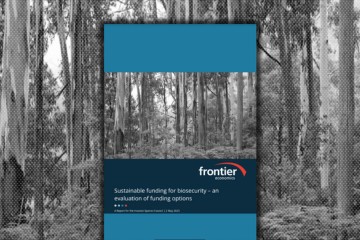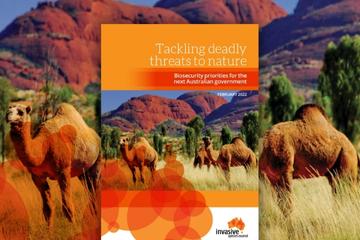Written by Invasive Species Council CEO Andrew Cox
An elusive promise
Unfortunately the lofty promise of the National Biosecurity Strategy is at risk.
Despite lots of hard work, 16 months after the strategy was adopted, delivery remains elusive.
As an insider in the development of both the strategy and now its implementation, I have had high hopes that there would be a new approach to biosecurity. Decision-making would be shared, we would work better together, new stable funding would be secured and we would all be better prepared for the next big invasive species threats (as well as being more effective in dealing with what is already here).
We have come a long way since the last two major reviews of biosecurity — the Beale review (2008) and Craik review (2017). There is more collaboration, especially between the federal government and states and territories and we are moving away from government-centric approaches. Modern biosecurity legislation is being rolled out across most governments, and risk features more heavily in decision-making. The needs of the environment are starting to be better factored into a largely agriculture-driven system.
Advancing the National Biosecurity Strategy
The strategy is a good document. If implemented, it would be transformative in the level of protection offered to Australia’s environment, economy and people.
The strategy had six worthwhile priorities: shared biosecurity culture, stronger partnerships, highly skilled workforce, coordinated preparedness and response, sustainable investment and integration supported by technology, research and data. These were supported by 36 ‘initial actions’ and a process to develop an implementation plan and action plan. This was to be overseen by the National Biosecurity Committee and a government/industry/community National Implementation Committee.
Nine meetings on, the implementation committee and the federal government staff members that facilitate the process are trying to keep the process on track. A draft implementation plan is due for release before the end of the year while the first action plan is due for delivery in April 2024. As the process progresses, the ambition lowers.
There is little progress on the 36 initial actions. The action plans that were meant to ‘build upon our initial actions’ are instead being directed to progress a selected number of the initial actions. There is no obvious new funding to implement key strategy proposals.
The main work on the shared biosecurity culture and stronger partnerships won’t emerge until next year. Sought after changes to improved governance arrangements to better include stakeholders or to boost collaborations are still to emerge. For now, there are no new major government-led collaborative initiatives or partnership arrangements.
Funding remains unsustainable
The sustainable funding goal, the key piece needed to deliver improved capacity across the system, is being bogged down by a proposal for a Biosecurity Protection Levy that raises funds from agricultural producers as beneficiaries of the biosecurity system. It has drained goodwill from the agricultural sector as few farming groups are supportive.
Despite the levy and increased recurrent funding, the federal Labor government has only partly implemented its pre-election promise to put in place sustainable long-term biosecurity funding. The risk creators — the importers — are still not contributing to the massive costs of the invasive species impacts they create. They are faced with increased ‘cost recovery’ charges to pay for the processing of their goods at the border, nothing more. The container levy proposed in 2018 has been abandoned. The multi-billion dollar costs of eradicating fire ants falls to Australian taxpayers, not the importers. There are few dedicated funding streams for the breadth of environmental biosecurity needs.
The weak link in our system is the capacity of state and territory governments that have no simple means to cover their ballooning costs. States and territories must have the means to prepare for and lead any biosecurity response, as well as co-fund the growing workload on behalf of other governments.
There is no process, either directly through the national biosecurity strategy implementation or the associated sustainable funding initiative, to address this deficiency.
Complete the survey
There is an opportunity right now to provide input about the direction of the strategy implementation. You have until 29 November 2023 to complete a survey that focuses on 4 of the 6 priority areas:
- Highly skilled workforce
- Coordinated preparedness and response
- Sustainable investment
- Integration supported by technology, research and data.
This round of consultation addresses only some of the concerns raised above. If you get a chance, answer the part of the survey about sustainable investment. Highlight the need to enhance capacity by imposing a levy on risk creators, such as through a container levy, and argue for dedicated funding for environmental biosecurity.
Finding a way forward
The Invasive Species Council will continue to find ways to drive transformative change to the biosecurity system that meaningfully includes industry and community. This includes actively supporting delivery of the goals of the National Biosecurity Strategy.
The Decade of Biosecurity initiative, of which we are a founding partner, is one area that shows great promise and can play a complementary role to deliver many of the strategy promises.
More information
Andrew Cox Invasive Species Council CEO and represented the Invasive Species Council on the working group that developed the National Biosecurity Strategy and is currently a member of the strategy’s National Implementation Committee.




